P1588
Placenta Growth Factor human
PlGF, recombinant, expressed in E. coli, powder, suitable for cell culture
Synonyme(s) :
PGF
About This Item
Produits recommandés
Source biologique
human
Niveau de qualité
Produit recombinant
expressed in E. coli
Pureté
≥95% (SDS-PAGE)
Forme
powder
Qualité
endotoxin tested
Poids mol.
29 kDa
Conditionnement
pkg of 10 and 50 μg
Conditions de stockage
avoid repeated freeze/thaw cycles
Technique(s)
cell culture | mammalian: suitable
Impuretés
<1.0 EU/μg
Conditions d'expédition
dry ice
Température de stockage
−70°C
Catégories apparentées
Actions biochimiques/physiologiques
Forme physique
Notes préparatoires
Reconstitution
Remarque sur l'analyse
Code de la classe de stockage
11 - Combustible Solids
Classe de danger pour l'eau (WGK)
WGK 3
Point d'éclair (°F)
Not applicable
Point d'éclair (°C)
Not applicable
Équipement de protection individuelle
Eyeshields, Gloves, type N95 (US)
Certificats d'analyse (COA)
Recherchez un Certificats d'analyse (COA) en saisissant le numéro de lot du produit. Les numéros de lot figurent sur l'étiquette du produit après les mots "Lot" ou "Batch".
Déjà en possession de ce produit ?
Retrouvez la documentation relative aux produits que vous avez récemment achetés dans la Bibliothèque de documents.
Articles
VEGF-A stimulates blood vessel growth via endothelial cell proliferation, migration, and survival during embryonic development.
Notre équipe de scientifiques dispose d'une expérience dans tous les secteurs de la recherche, notamment en sciences de la vie, science des matériaux, synthèse chimique, chromatographie, analyse et dans de nombreux autres domaines..
Contacter notre Service technique







